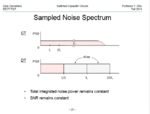akbarza
Full Member level 2
Hi
in file switch-capacitor circuits from Prof. Y.Chiu -data converters eect 7327 in slide 25,
he has said that Total integrated noise power remains constant( pic: niose.png).
but i think because of aliasing in sampling the
noise is aggressive of some noise spectrum as I drawn in alias.png.( i drew pic in paint, if is bad excuse me)
so because noise is random in phase, the sum tend to zero and PSD(power spectral density) of sample noise must be approximately zero. this is my
explanation: for switch capacitor circuit(with two phase ph_1 and ph_2) , some noise in ph_1 is created and then this noise with input signal in ph_2 is sampled. i think with this sampling,the created noise in ph_1 is eliminated(for withe noise because of infinite bandwidth ). but in ph_2, new noise is created by switches that remains and appears in output.
this is my opinion. am i wrong?
please explain and thanks.


in file switch-capacitor circuits from Prof. Y.Chiu -data converters eect 7327 in slide 25,
he has said that Total integrated noise power remains constant( pic: niose.png).
but i think because of aliasing in sampling the
noise is aggressive of some noise spectrum as I drawn in alias.png.( i drew pic in paint, if is bad excuse me)
so because noise is random in phase, the sum tend to zero and PSD(power spectral density) of sample noise must be approximately zero. this is my
explanation: for switch capacitor circuit(with two phase ph_1 and ph_2) , some noise in ph_1 is created and then this noise with input signal in ph_2 is sampled. i think with this sampling,the created noise in ph_1 is eliminated(for withe noise because of infinite bandwidth ). but in ph_2, new noise is created by switches that remains and appears in output.
this is my opinion. am i wrong?
please explain and thanks.

